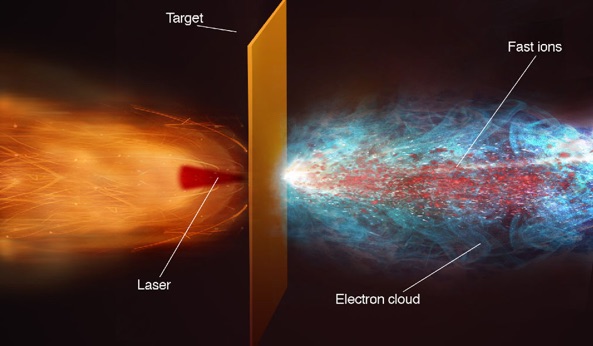Particle acceleration and secondary sources
Acceleration of particle in plasmas exploits the ultralarge electric fields (up to 1013 V/m) that can be generated by inducing a local charge separation. This is at the basis of novel approaches for acceleration of electrons and ions which are pursued by many groups and projects worldwide. These activities are motivated by the search for compact alternatives to high-energy Radiofrequency accelerators, but also by novel applications facilitated by some of the peculiar properties of laser-accelerated beams.

At QUB, we pursue, in particular, research in the acceleration of ions, and we have contributed over the year some major developments to this field of research. In the framework of sheath acceleration processes on foil targets driven by intense, ultrashort laser pulses, experiments have demonstrated, over a wide range of laser and target parameters, the generation of multi-MeV proton and ion beams with ultrashort duration, high brilliance, and low emittance. Recent activities have focused on advanced acceleration mechanisms which aim to harness the enormous radiation pressure associated to ultra-intense, short laser pulses to accelerate ions directly from the bulk of ultrathin foils (10-100 nm thick). Expansion of the foils during the irradiation may lead to regimes where an enhanced coupling and complex interplay between laser radiation, electron and ions in the plasma can also enhance the acceleration efficiency. We are also engaged in the development of target-based techniques which act on the ions after their acceleration from a foil, in order to optimize their properties (such as divergence and energy spectrum) towards applicative use of the ions.
Acceleration of electrons typically takes place in plasmas produced from gaseous media, through the so-called wakefield acceleration process, based on the excitation of a large amplitude plasma wave in the wake of an intense, ultrashort laser pulse. Electron energies up to several GeV in mono-energetic bunches can be obtained through this approach on state-of-the-art laser systems such as the GEMINI laser at RAL.
An emerging research theme at QUB is the operation of plasma accelerators at high repetition rates and their automated control and optimization via machine learning techniques.
Laser-accelerated particles are also used to generate secondary particle sources, generated through the interaction of laser-accelerated electrons and ions with suitable targets. Beams of neutrons are produced through nuclear reactions initiated by the ions, either inside the laser-irradiated primary target or when directed to a suitably chosen secondary target, in the so-called pitcher-catcher scheme. The reactions produce directional beams of neutrons with MeV energies and short pulse duration (typically containing 109-1010 neutrons in a nanosecond pulse), which can be further moderated to the epithermal and thermal regimes in compact arrangements. Positrons are generated by directing ultrarelativistic electron beams (accelerated by intense femtosecond laser pulses in gaseous media trough wakefield processes) onto high-Z targets. The electrons initiate electromagnetic cascades, which lead to the emission of bright fluxes of gamma photons and high-energy positrons. Highly directional, high brightness beams of 100s MeV positrons have been demonstrated so far, with options for further acceleration and use in higher energy physics applications. By tuning the generation conditions, it is possible to obtain neutral electron-positron beams, which are of high relevance for laboratory astrophysics applications.
KEY RECENT PUBLICATIONS:
1. B. Loughran, M. J. V. Streeter, H. Ahmed, S. Astbury, M. Balcazar, M. Borghesi, N. Bourgeois, C. B. Curry, S. J. D. Dann, S. Diiorio, N. P. Dover, T. Dzelzainis, O. C. Ettlinger, M. Gauthier, L. Giuffrida, G. D. Glenn, S. H. Glenzer, J. S. Green, R. J. Gray, G. S. HicksC. Hyland, V. Istokskaia, M. King, D. Margarone, O. McCusker, P. McKenna, Z. Najmudin, C. Parisuaña, P. Parsons, C. Spindloe, D. R. Symes, A. G. R. Thomas, F. Treffert, N. Xu, C. A. J. Palmer, Automated control and optimization of laser-driven ion acceleration, High Power Laser Sci. Eng, 11, e35 (2023)
2. S. Ferguson, P. Martin, H. Ahmed, E. Aktan, M. Alanazi, M. Cerchez, D. Doria, J. S. Green, B. Greenwood, B. Odlozilik, O. Willi, M. Borghesi, S. Kar, Dual stage approach to laser-driven helical coil proton acceleration, New J. Phys., 25, 013006 (2023)
3. A. Alejo, H. Ahmed, A.G. Krygier, R. J. Clarke, R. R. Freeman, J. Fuchs, A. Green, J. S. Green, D. Jung, A. Kleinschmidt, J. T. Morrison, Z. Najmudin, H. Nakamura, P. Norreys, M. Notley, M. Oliver, M. Roth, L. Vassura, M. Zepf, M. Borghesi, S. Kar, Stabilized radiation pressure acceleration and neutron generation in ultrathin deuterated foils, Phys. Rev. Lett. 129, 114801 (2022)
4. J. Sarma, A. McIlvenny, N. Das, M. Borghesi, A. Macchi, Surface plasmon-driven electron and proton acceleration without grating coupling, New J. Phys, 24 , 073023 (2022)
3. G. Sarri, L. Calvin, M. Streeter, Plasma based positron sources at EuPRAXIA, Plasma Phys. Control. Fusion, 64, 044001 (2022)
5. A. McIlvenny, D. Doria, L. Romagnani, H. Ahmed, N. Booth, E-J Ditter, G. Hicks, O.C. Ettlinger, P. Martin, G.G. Scott, S. D. R. Williamson, A. Macchi, P. McKenna, Z. Najmudin, D. Neely, S. Kar, M. Borghesi, Selective Ion Acceleration by Intense Radiation Pressure, Phys. Rev. Lett.,.127, 194801 (2021)
CURRENT FUNDING:
AIPA: Artificially intelligent plasma accelerators, University Research Fellowship, Royal Society (2022-2026)
EUPRAXIA- HORIZON, Innovate UK (2022-26)
Ultra-short and tuneable positron beams for high-resolution and volumetric inspection of materials, EPSRC EP/V044397/1 (2021-22)
IMPULSE (Integrated Management and Reliable Operations for User-based Laser Scientific Excellence), EU H2020 871161 (2020-23)
